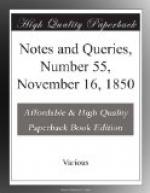C.
Tristan d’Acunha (Vol. ii., p. 358.).—The island is noticed, but briefly, in p. 54. of the first volume of Perouse’s Voyage round the World, Lond. 1799. It is there stated that a tolerably minute account of it is contained in Le Neptune Oriental, by D’Apres (or Apres de Manvilette). This work was published in Paris, 1775, in two volumes, large folio.
C.I.R.
Arabic Numerals (Vol.ii., pp. 27. 61. 339.).— In a work in Arabic, by Ahmad ben Abubekr bin Wahshih, on Ancient Alphabets, published in the original, and accompanied with an English translation, by Von Hammer, your correspondent on the subject of Arabic numerals will find that these numerals were not invented as arbitrary signs, and borrowed for various alphabets; but that they are actually taken from an Indian alphabet of nine characters, the remaining letters being made up at each decimal by repeating the nine characters, with one or two dots. The English Preface states that this alphabet is still in use in India, not merely as a representative of numbers, but of letters of native language. The book is a neat quarto, printed in London in 1806; and the alphabet occurs in page 7. of the Arabic original.
E.C.H.
Athenaeum.
Luther’s Hymns (Vol. ii., p. 327.).—If F.Q. will turn to Mr. Palmer’s Origines Liturgicae, vol. ii. p. 238. 4th edit., he will find that the sentence in the Burial Service, “In the midst of life we are in death,” &c., is taken from the Salisbury Breviary Psalter. The Salisbury Use was drawn up by Bishop Osmund in the eleventh century.
N.E.R. (a Subscriber.)
Bolton’s Ace.—What is the meaning of “Bolton’s Ace,” in the following passage in the address to the reader prefixed to Henry Hutton’s Follies Anatomie, 8vo. Lond. 1618? It is passed over by DR. RIMBAULT in his reprint of the work for the Percy Society in 1842:
“Could ye attacke this felon in’s
disgrace,
I would not bate an inch (not Bolton’s
ace)
To baite, deride, nay, ride this silly
asse.”
J. CT.
["Bate me an ace quoth Bolton” is an old proverb of unknown origin. Ray tells us that a Collection of Proverbs having been presented to Queen Elizabeth, with an assurance that it contained all the proverbs in the English language. “Bate me an ace, quoth Bolton,” said the queen, implying that the assertion was too strong; and, in fact, that every proverb was not in the collection. See Nares’ Glossary, who quotes the following epigram by H.P., to show the collection referred to
“Secundae Cogitutiones meliores.
“A pamphlet was of proverbs penned
by Polton,
Wherein he thought all sorts
included were;
Untill one told him Bate m’ an
ace quoth Bolton,
‘Indeed,’ said
he, ‘that proverb is not there.’”]




